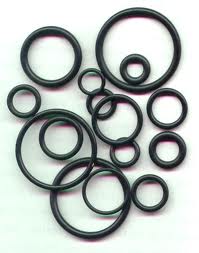The humble O-ring is one of the simplest, yet most engineered, precise, and useful seal designs ever developed and is one of the most common and important elements of machine design.
O-Rings are manufactured in metric and imperial sizes and come in a variety of designs. A number of  various size specifications exist and care must be taken to ensure you are purchasing the correct size specification.
various size specifications exist and care must be taken to ensure you are purchasing the correct size specification.
The reason that O-rings are commonly used in machine design is that they are inexpensive, easy to manufacture, reliable, and have simple mounting requirements in both static and dynamic mounting applications.
Thomas Edison way back in 1882 used a round rubber ring as part of his light bulb patent. A Swede patented an O-ring on the 12 of May 1896. It was an inventor, Niels Christensen who perfected the O-rings while developing automobile brakes. He patented his O-ring in 1937, however, there was no interest until the aircraft boom of World War II. Christensen sold his O-rings to the military after tests proved the simple, critical O-rings enabled a complex technology to advance.
O-ring Applications
Successful O-ring joint design requires a rigid mechanical mounting that applies a predictable deformation to the O-ring. This introduces a calculated mechanical stress at the O-ring contacting surfaces. As long as the pressure of the fluid being contained does not exceed the contact stress of the O-ring, leaking cannot occur. Fortunately, the pressure of the contained fluid transfers through the essentially incompressible o-ring material, and the contact stress rises with increasing pressure. For this reason, an O-ring can easily seal high pressure as long as it does not fail mechanically. The most common failure is extrusion through the mating parts.
The seal is designed to have a point of contact between O-rings and sealing faces. This allows a high local stress, able to contain high pressure, without exceeding the yield stress of the O-ring body. The flexible nature of O-ring materials accommodates imperfections in the mounting parts. Surface finish is also especially important in dynamic applications. A surface finish that is too rough will abrade the surface of the o-ring, and a surface that is too smooth will not allow the seal to be adequately lubricated by a fluid film.
Reference: http://en.wikipedia.org/wiki/O-ring
FUZION TRADING are accredited agent for GAPI of Italy manufactures a range of O-rings that is world-renowned for quality. To complement our manufacturing facility we have partnered with Gapi to stock this outstanding range of O-rings.



